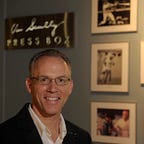OTD: Sandy’s second no-no
by Mark Langill
There wasn’t much surprise when Sandy Koufax pitched his second career no-hitter on May 11, 1963, during an 8–0 victory against the San Francisco Giants at Dodger Stadium. Great expectations followed Koufax to the pitcher’s mound during each of the final six years of his abbreviated Hall of Fame career that ended in 1966 at age 30 due to arthritis in his left elbow.
“Every night, Sandy was a threat to pitch a no-hitter,” said Tommy Davis, the two-time National League batting champion who in 1963 alternated between third base and left field. “It was tough to play defense behind Sandy, because you sometimes felt like a spectator and forget the batter might hit the ball in your direction.”
Koufax won NL Most Valuable Player in 1963 with a 25–5 regular season record, 1.88 ERA and 11 shutouts. In the World Series, he pitched two complete games during a four-game sweep of the New York Yankees, including a record 15 strikeouts in the opener at Yankee Stadium.
But Koufax wasn’t a lock to perform in 1963 because of a circulatory problem in his left index finger which sidelined him for most of the second half of 1962 when the Dodgers lost the pennant to San Francisco in a three-game playoff. Just two weeks after his first no-hitter against the expansion New York Mets on June 30, Koufax’s finger went numb. Koufax initially didn’t disclose the injury because he wanted to stay in the starting rotation. After consulting with various doctors, the diagnosis was a crushed artery in the palm of his hand, likely caused in April when batting left-handed against Pittsburgh’s Earl Francis. Koufax was jammed with a pitch and the heel of the bat dug into the palm.
Koufax eventually recovered and showed his old form during Spring Training in 1963. A stiff shoulder in April forced Koufax onto the sidelines for two weeks, but by early May, he was ready for the early-season matchup with San Francisco’s Juan Marichal in Los Angeles. So were the Dodger fans, as 55,530 gathered on a Saturday night, the biggest crowd in the 13-month history of the stadium.
Missing from the chaotic scene was Dodger scout Tommy Lasorda, who had his own unique history with Koufax. Lasorda’s brief MLB pitching career with the Dodgers had ended in 1955 when he was sent to Triple-A Montreal to make room for the 19-year-old Koufax, whose bonus contract status mandated Major League roster status. Lasorda, who as a scout always carried a right-handed catcher’s mitt in the trunk of his car in case of an impromptu tryout, had been asked the previous day by LA general manager Buzzie Bavasi to catch Koufax in a makeshift bullpen session to test the shoulder. Lasorda said he told Koufax, “With stuff like that, tomorrow you’ve got to throw a no-hitter.”
Lasorda, though, accepted a dinner invitation from former Brooklyn Minor Leaguer Chuck Connors, then a television star. Lasorda learned through his transistor radio at the dinner table that Koufax was flirting with a perfect game as he retired San Francisco’s first 22 batters. The last perfect game in the Majors had been pitched by the Yankees’ Don Larsen against the Brooklyn Dodgers in the 1956 World Series. Then a journeyman reliever, Larsen watched Koufax from his seat in the San Francisco bullpen.
The Dodgers supported Koufax with four runs against Marichal. Wally Moon homered in the second inning and added an RBI single during a three-run sixth inning to give LA. a 4–0 cushion. The Dodgers added four runs in the eighth against reliever John Pregenzer.
Koufax, whose four strikeouts were the fewest among his four career no-hitters, needed 111 pitches and some help from his defense. In the seventh inning, Harvey Kuenn lined out to right fielder Frank Howard. Felipe Alou hit a drive toward the left field fence. Members of the Dodger bullpen yelled at Davis that he had room as Davis caught the ball in front of the fence. Willie Mays roped a drive toward left, but third baseman Jim Gilliam made a backhanded stab behind the bag.
In the eighth inning, Orlando Cepeda hit a sharp grounder off Koufax’s glove. The ball bounced to second baseman Nate Oliver, who threw out Cepeda by a step. The perfect game ended when Ed Bailey drew a one-out walk on a full-count pitch.
The only ninth-inning drama occurred after Koufax issued a two-out walk to pinch-hitter Willie McCovey. Kuenn hit a soft grounder to Koufax, which immediately worried first baseman Ron Fairly. On a similar play years earlier, in Fairly’s first game at the position, Koufax fired a fastball that Fairly wasn’t expecting. Fairly missed the catch and the ball chipped Fairly’s protective cup. This time, Koufax gently threw the ball underhanded and the celebration commenced.
After the game, Koufax called the second no-hitter his “biggest thrill” when asked to compare other great games like his 18 strikeouts against the Giants in 1959 at the Los Angeles Coliseum and the no-hitter in 1962 against the Mets.
“I guess I would say that for two reasons,” Koufax said. “Because it was against the Giants and because it came after my finger and shoulder ailments. You have to have a lot of good luck to pitch a no-hitter. There wasn’t a soft spot in the Giants lineup. Even Marichal is a good hitter.”
